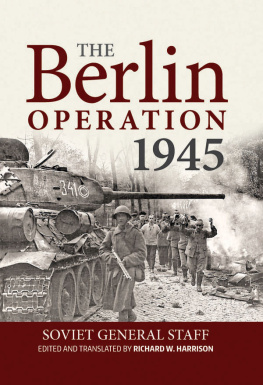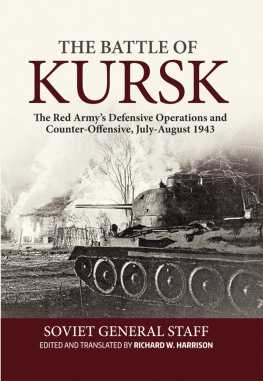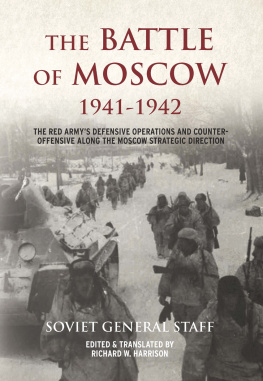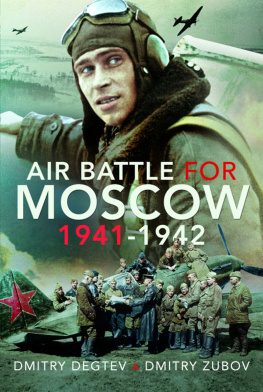The Battle of Moscow, 19411942: The Red Armys Defensive Operations and Counteroffensive Along the Moscow Strategic Direction is a detailed examination of one of the major turning points of World War II, as seen from the Soviet side. The Battle of Moscow marked the climax of Hitlers Operation Barbarossa, which sought to destroy the Soviet Union in a single campaign and ensure German hegemony in Europe. The failure to do so condemned Germany to a prolonged war it could not win.
This work originally appeared in 1943, under the title Razgrom Nemetskikh Voisk pod Moskvoi (The Rout of the German Forces Around Moscow). The work was produced by the Red Army General Staffs military-historical section, which was charged with collecting and analyzing the wars experience and disseminating it to the armys higher echelons. This was a collective effort, featuring many different contributors, with Marshal Boris Mikhailovich Shaposhnikov, former chief of the Red Army General Staff and then head of the General Staff Academy, serving as general editor.
The book is divided into three parts, each dealing with a specific phase of the battle. The first traces the Western Fronts defensive operations along the Moscow direction during Army Group Centers final push toward the capital in NovemberDecember, 1941. The study pays particular attention to the Red Armys resistance to the Germans attempts to outflank Moscow from the north. Equally important were the defensive operations to the south of Moscow, where the Germans sought to push forward their other encircling flank.
The second part deals with the first phase of the Red Armys counteroffensive, which was aimed at pushing back the German pincers and removing the immediate threat to Moscow. Here the Soviets were able to throw the Germans back and flatten both salients, particularly in the south, where they were able to make deep inroads into the enemy front to the west and northwest.
The final section examines the further development of the counteroffensive until the end of January 1942. This section highlights the Soviet advance all along the front and their determined but unsuccessful attempts to cut off the Germans RzhevVyazma salient. It is from this point that the front essentially stabilized, after which events shifted to the south.
This new translation into English makes available to a wider readership this valuable study.
Richard W. Harrison earned his undergraduate and masters degrees from Georgetown University, where he specialized in Russian area studies. In 1994 he earned his doctorate in War Studies from Kings College London. He also was an exchange student in the former Soviet Union and spent several years living and working in post-communist Russia.
Dr. Harrison has worked for the US Department of Defense as an investigator in Russia, dealing with cases involving POWs and MIAs. He has also taught Russian history and military history at college and university level, most recently at the US Military Academy at West Point.
Harrison is the author of two books dealing with the Red Armys theoretical development during the interwar period: The Russian Way of War: Operational Art, 19041940 (2001), and Architect of Soviet Victory in World War II: The Life and Theories of G.S. Isserson (2010). He has also authored a number of articles on topics in Soviet military history. He is currently working on a history of the Red Armys high commands during World War II and afterwards.
Dr. Harrison currently lives with his family near Carlisle, Pennsylvania.
THE BATTLE OF MOSCOW 19411942
THE BATTLE OF MOSCOW 19411942
The Red Armys Defensive Operations and Counteroffensive along the Moscow Strategic Direction
Soviet General Staff
Edited and translated by Richard W. Harrison
Helion & Company
Published in cooperation with the Association of the United States Army
Helion & Company Limited
26 Willow Road
Solihull
West Midlands
B91 1UE
Tel. 0121 705 3393
Fax 0121 711 4075
Email:
Website: www.helion.co.uk
Twitter:
Visit our blog http://blog.helion.co.uk/
Published by Helion & Company 2015, in cooperation with the Association of the United States Army
Designed and typeset by Bookcraft Ltd, Stroud, Gloucestershire
Cover designed by Euan Carter, Leicester ( www.euancarter.com )
Text and maps Association of the United States Army. English edition translated and edited by Richard W. Harrison. Maps drawn by David Rennie.
ISBN 978 1 910294 64 2
eISBN 978 1 912174 61 4
Mobi ISBN 978 1 912174 61 4
British Library Cataloguing-in-Publication Data.
A catalogue record for this book is available from the British Library.
All rights reserved. No part of this publication may be reproduced, stored in a retrieval system, or transmitted, in any form, or by any means, electronic, mechanical, photocopying, recording or otherwise, without the express written consent of Helion & Company Limited.
For details of other military history titles published by Helion & Company Limited contact the above address, or visit our website: http://www.helion.co.uk.
We always welcome receiving book proposals from prospective authors.
Part I
A short description of the theater of military activities
Part II
The failure of the first offensive of the German-Fascist troops on Moscow. The general situation on the Western Front at the beginning of November 1941
Part III
The second general offensive on Moscow by the German-Fascist troops and the defensive battle on the Western Front (November 16-December 1941)
Part IV
The Red Armys counteroffensive on the Western Front and the defeat of the German-Fascist troops around Moscow (December 6-December 24 1941)
Part V
The offensive by the Western Fronts troops from the line of the Lama, Ruza, Nara, and Oka rivers (December 25 1941-January 31 1942)
Part VI
Overall conclusions on the Moscow Operation
List of Maps
The Situation Along the Moscow Strategic Direction, October 12-November 15
The Withdrawal of the Western Fronts Right Flank in November, 1941
The Armies Defense of the Central Sector on November 16
The Withdrawal by the Fronts Left-Wing Forces in November and the Counterblow by the 1st Guards Cavalry Corps in December, 1941
The Germans November Offensive on Moscow in 1941
The Situation by December 6
The Situation to the North of Moscow on December 6 and the Western Front Commands Plan







